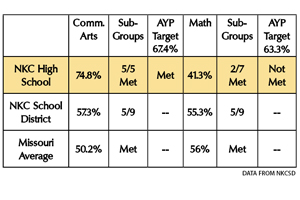For the past two years, Northtown has not met Adequate Yearly Progress, or AYP, in mathematics for No Child Left Behind.
This means that in math students did not meet a goal set nation wide for all public schools. The goal is to have a 100 percent proficiency in reading and math.
“Any educator would say that is a worthy goal, but the reality is some students, for a variety of reasons aren’t ready and we can’t get them there. It is a reflection on us and other things,” counselor Martha DeVries said.
Since Northtown did not make AYP, students were allowed the option to go to Staley, who did meet the AYP,.Winnentonka students got the same option. Winnetonka and NKCHS are Title One schools and receive more money to provide services for students.
“Staley serves a different population. Several factors go into how well students perform, like family support and socioeconomics. Students who feed into Staley have higher income and often have parents who are more involved,” DeVries said.
It is not as though parents at Northtown might not want to be involved.
“We have more students who live in poverty and that makes it harder to be involved if they are trying to work two jobs and they might not have the skills to help,” DeVries said.
DeVries felt that students did not want to go to Staley, however.
“Kids didn’t leave because of the relationships with teachers and peers. There are some students who would do anything in the world for their teachers. They feel Northtown is a safe place, and I’m sure Staley is too, but it could be intimidating,” DeVries said.
The school has also been making some progress between the 2008 and 2009 school years.
“Our scores are good and we raised them a lot. We take kids who struggle and move them ahead,” DeVries said.
DeVries said that the school moved ahead by 17 points.
Jennifer Cogburn has done research to see what the best way was to get that large of a jump in the score.
“I went to Eastgate and Northgate and talked to eighth grade teachers and asked them the amount of help that would be needed for each student,” Cogburn said.
What ended up happening was having three groups of students, about 60 in a group. The first group took a pilot class called Introduction to High School Math.
“It is a math credit but not an Algebra credit. It will be used to get students ready for Algebra I,” Cogburn said.
In group two is students who teachers felt would be ready for Algebra I, but would need help.
“We built Algebra into their schedule everyday. On one day they will have the class and will get help the next day,” Cogburn said.
In group three is students who could succeed in Algebra and progress on their own.
There is a fourth group who come into high school past Algebra already.
“We went back and looked at eighth grade math grades and those who struggled with organizational skills or content, we got them into the class where they could have extra help,” Cogburn said.
One of the problems teachers also saw was just skill level.
“We started spiraling the homework so that there is always a lot of review. In case a student didn’t master the technique by the test they still have problems to practice that skill with,” Cogburn said.
Cogburn and DeVries did not feel worried about the AYP scores.
“We are realistic and feel good, and know we and the students are working hard,” Cogburn said.
DeVries also felt good about how Northtown was doing and while AYP scores are important, they are not everything.
“Just like a test is a snapshot of a student, an AYP is a snapshot of the school and we are so much more than that,” DeVries said.










